Speech Some Recent (and not so recent) Trends in Australian Debt Markets
Thank you for inviting me to speak here again. Today, I'm going to talk about the local debt market. I'll talk about the current state of play as well as a bit of history.
Market Developments
This time last year, debt markets globally weren't in great shape, though the local market wasn't faring too badly. A year on, global debt markets are in a much better position, with issuance strong across most parts of the market, spreads considerably lower and the absolute level of yields very low by historical standards.
The market's assessment of the likelihood of extreme outcomes has declined. The risks in Europe are still predominantly negative, but in China, the US and non-Japan Asia, the risks are much more balanced – one can even conceive of upside surprises!
Australia's financial markets have been influenced by these global factors. At the same time, domestic markets have benefited from strong international demand for Australian dollar assets. Local issuers continue to be viewed favourably by offshore investors looking to diversify credit exposures.
Yields on Commonwealth Government securities have moved in line with global government bond yields. They are around post-federation lows, as this very long-run graph demonstrates (Graph 1). Semi-government spreads have tended to move in a fairly tight range. Yields on state government debt are also around their lowest since Federation, notwithstanding the occasional ratings downgrade.
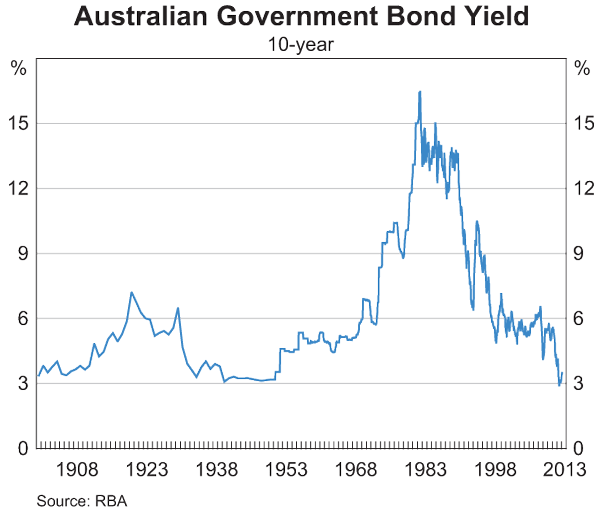
Demand for CGS from offshore investors remains strong (Graph 2). The share of foreign ownership has come off its recent peak but net purchases have still continued, just not in line with the pace of issuance. There have been reports of Japanese investors selling, in large part because of the high level of the AUD/JPY exchange rate, but these sales have been more than compensated for by increased purchases by other investors.[1] The foreign ownership of semis has been relatively constant, partly reflecting the preference the foreign official sector generally displays for sovereign or highly rated supranational paper rather than state or provincial debt. Instead, much of the increase in semi supply over the past couple of years has been met by the demand from domestic bank balance sheets looking to boost their liquid asset holdings.
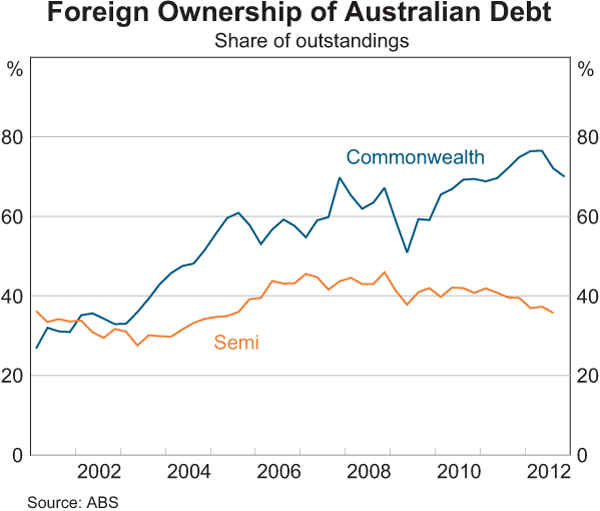
For financial institutions, the cost of unsecured wholesale debt has fallen sufficiently to make it economical for them to replace some of their government guaranteed securities. As we noted in a recent box in the Statement on Monetary Policy,[2] banks began repurchasing this debt in large amounts towards the end of last year, and buybacks have totalled around $19 billion since the end of September (Graph 3). As a result, the contingent liability the scheme generates for the Australian Government has fallen more quickly than implied by the maturity profile of guaranteed securities, and currently stands at $53 billion.

The ability to issue covered bonds has also helped in the repurchasing of guaranteed debt, as banks can offer investors with AAA mandates an alternative asset to invest in. Covered bonds have enabled banks to diversify their investor base, and have provided issuers with a wholesale funding source less sensitive to risk events than traditional unsecured funding.
After strong issuance in the beginning of 2012 as the banks ramped up their programs, covered bond issuance by Australian banks slowed as the year progressed, in large part reflecting banks' desire to spread out the maturity profile. The major banks have utilised around 30 per cent of their issuance caps to date. Spreads on these covered bonds have tightened significantly since the first transaction in late 2011, reflecting not only the general improvement in global risk sentiment, but also increased familiarity with the product and a widening investor pool. Australian covered bonds now price at a level close to much longer established covered bond programs (Graph 4).

The general decline in borrowing costs in the second half of 2012 has helped entice a number of issuers back to the wholesale market, with volumes picking up across all markets towards the end of last year and into the first quarter of 2013 (Graph 5).
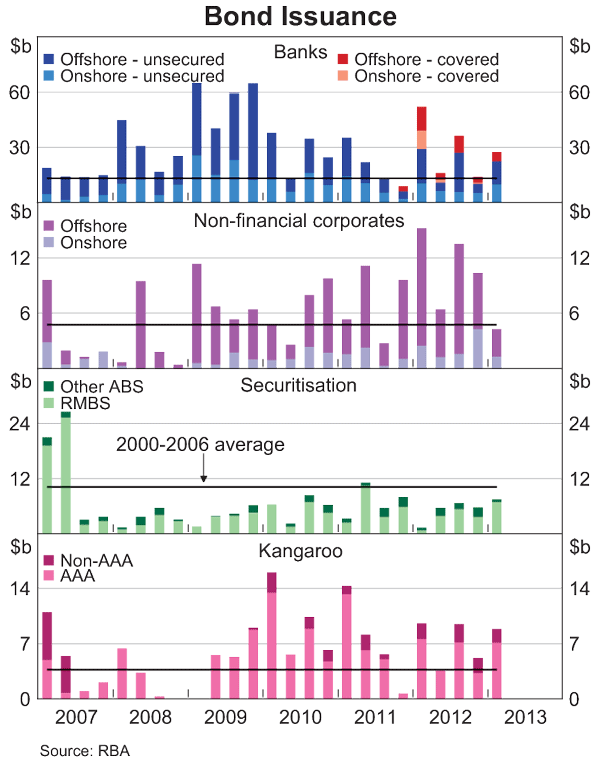
In the unsecured market, banks continue to keep their stock of term debt relatively constant, that is, issuance is broadly in line with maturities. This strategy is the result of a number of different considerations, including the relatively subdued growth in balance sheets. But one dominant cause is the desire to maintain a strong rating, with the latent threat of a downgrade if wholesale issuance were to grow ‘too large’. This reflects the somewhat misplaced assessment of ‘deposits good, wholesale funding bad’. As a result, banks are currently paying about the same price for a 3-month term deposit as they are for a 5-year debt issue.
Banks have taken advantage of the increase in risk appetite by lengthening the tenor of their issuance. The average tenor of unsecured issuance has been 5 years since the middle of last year, compared with a little over 4 years since the beginning of the financial crisis. Increasing tenor has also been a feature of other markets. For example, the Australian Office of Financial Management (AOFM) extended the average tenor of CGS issuance in 2011/12 by over a year to 7.7 years,[3] while over the past 12 months the tenor of corporate issuance has increased to nearly 11 years, compared with an average of 8 years since the beginning of the financial crisis.
The securitisation market has only recently caught up to these trends, lagging behind most other segments of the debt market. Issuance has picked up of late and spreads have tightened considerably following the earlier sizeable tightening in covered bond spreads. Encouragingly, recent issuance has been completed with little or no support from the AOFM due to strong private investor demand, and primary market spreads are at their tightest level since 2007 (Graph 6). This spread tightening will lower the cost of mortgage lending for small banks and non-bank lenders who rely on securitisation for a large part of their funding.

Conditions have also picked up in the Kangaroo market. Ten kangaroo issuers debuted in the market in 2012. The diversity of new issuers was also a notable feature, and included Asian names and non-financial corporates. Another positive development has been the re-emergence of some non-SSA issuers not seen since the start of the global financial crisis, while more recently a number of European issuers have returned to the market after being absent for much of 2012.
Kangaroo issuance has been supported by the broad-based reduction in spreads, the attractive basis, and foreign investors looking beyond AAA instruments for Australian dollar exposure. These foreign investors have been notably active and Asian investor participation in particular continues to grow.
Some Recent RBA Initiatives in Australian Debt Markets
I will now briefly discuss two recent RBA initiatives concerning the local debt market.
Firstly, the Reserve Bank is in the process of signing two-way credit support annexes with all of its swap counterparties. A number of these agreements are already operational, including those with the Bank's largest counterparties, and we expect agreements to be in place with all counterparties in the coming weeks. This move is in line with best practices in risk management. As more market participants collateralise their exposures in both directions, this should also free collateral for the system (in aggregate), and enhance liquidity and the resilience of the Australian derivatives markets.
Secondly, late last year, the Reserve Bank announced new data reporting requirements for repo-eligible RMBS. The information required by the Bank includes loan-level and other transaction specific data that issuers must also make publicly available. These initiatives are designed to help the Bank assess the quality of RMBS provided as collateral and will also improve the transparency of the market as a whole. For investors, the data will be easier to access and because the reporting templates are standardised, investors can better compare the underlying credit characteristics of different deals, and also use the data in their own analytics.
The consultation period for the proposed reporting templates closed at the end of last year. The Bank is currently reviewing the consultation findings and will finalise the reporting templates over the next month or so.
A Long-run Perspective on Australian Corporate Bond Issuance
I will now turn to the corporate bond market. Non-financial corporate issuance has also been robust, and was particularly strong towards the end of last year, led by some large deals from the mining sector. The December quarter was the strongest on record for domestic activity, with BHP's $1 billion transaction receiving significant interest. The deal is the largest ever non-credit wrapped transaction in the domestic market by a corporate issuer.
To place these more recent trends in a longer-term context, I'd like to take a moment to consider how Australia's corporate debt markets have evolved into their present form. The current corporate bond landscape is the result of a number of significant developments over the past century, outlined in a recent Reserve Bank Research Discussion Paper published in late 2012.[4] This paper was the result of a substantial data collection exercise and extends our understanding of Australian bond issuance back to 1917.
Broadly speaking, trends in bond issuance by Australian corporations can be broken down into three distinct periods (Graph 7). The first, which extended throughout the first half of the 20th century, actually saw the peak in the size of the corporate bond market relative to GDP. This period, particularly prior to World War II, was characterised by significant issuance by government-owned Public Trading Enterprises (PTEs). Private investment, on the other hand, was largely financed through internal funds, and the modest private bond issuance that did occur was mostly to fund mining investment, much of it by corporations that later went on to become BHP.
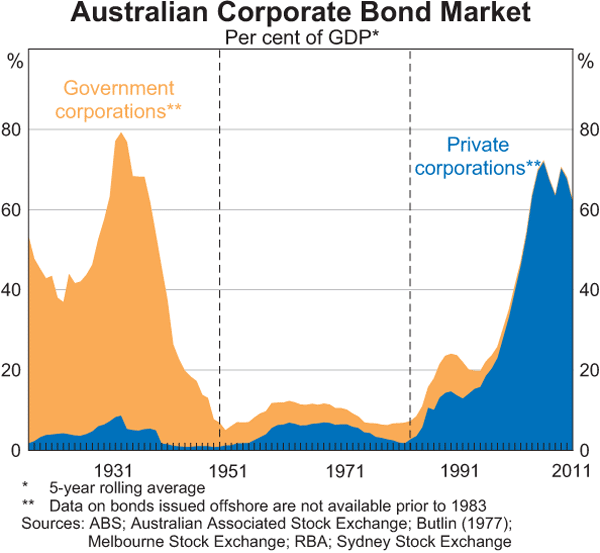
The bulk of the issuance by government-owned corporations took place in the 1920s. The proceeds were used mostly to fund public works programs, with investment by these PTEs accounting for as much as 7 per cent of GDP. Half of the bond issuance was by Victorian water and sanitation boards alone. Public works projects undertaken here in Sydney, on the other hand, including the building of the Sydney Harbour Bridge and Sydney's underground railway system, were mostly funded directly by governments.
Over the 1930s and 1940s, the stock of corporate bonds outstanding declined as governments reallocated resources away from the PTEs to finance war-related expenditure. By the end of the Second World War, the corporate bond market had shrunk to around 18 per cent of GDP.
As the economy expanded following World War II, the stock of corporate bonds remained relatively small as a share of GDP. At the same time, the corporate bond market began to shift towards a larger share of private issuance, in part to fund mining investment, and as corporations looked to source capital from outside the heavily regulated banking system (Graph 8).
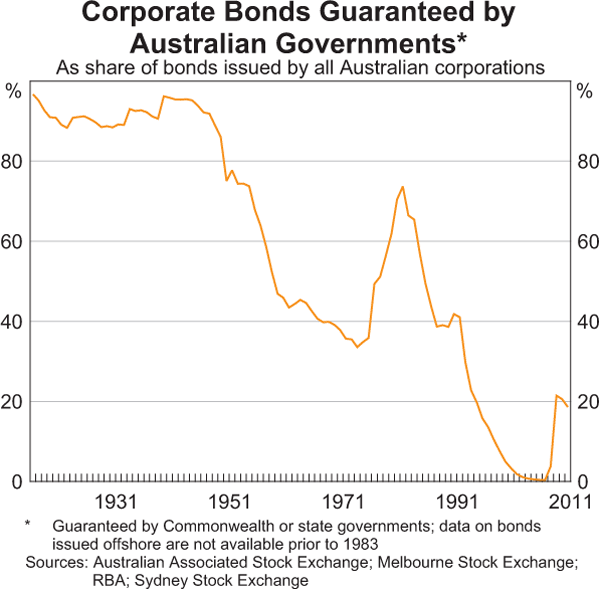
Bond issuance trends changed significantly from the early 1980s onwards as the Australian economy and financial system underwent large structural changes. Financial deregulation and liberalisation in the late 1970s and early 1980s saw banks rely less on deposits and instead turn to the capital markets to fund balance sheet growth. As we know, bank bond issuance has since grown rapidly, and banks have become the largest issuers of Australian bonds (Graph 9).

Some other notable trends since the early 1980s have included the large number of privatisations, which has resulted in the share of quasi-government bonds falling to close to zero, and the growth of the asset-backed market. On the investor side, compulsory super and increased offshore issuance caused a shift away from direct holdings by households towards indirect holdings through superannuation funds and non-resident investors.
Another important development was the abolition of capital controls and the floating of the Australian dollar. Prior to the 1980s, there were a range of constraints on capital flows that were intended to prevent or discourage firms from undertaking foreign borrowing. Since these controls were relaxed, banks and other corporations have obtained a significant proportion of funding from offshore bond markets. Since 1986, the stock of bonds issued offshore by Australian residents has exceeded the size of the onshore market (Graph 10).
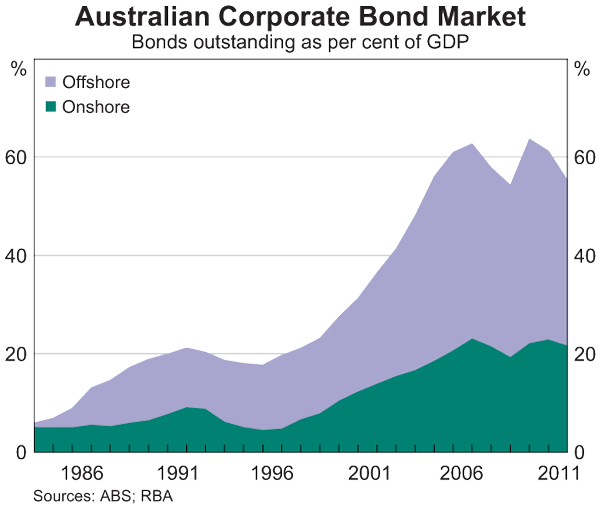
The liberalisation of the capital account also contributed to the development of the ‘Kangaroo’ bond market. Kangaroo issuance was also encouraged by, and contributed to, the development of an active cross-currency interest rate swap market in Australia.
I will finish with a few thoughts on the current state of the domestic corporate bond market. There is a fair amount of discussion about the size, liquidity and functionality of the local market. Let me raise three issues worth considering:
- Is the local corporate sector too banked? The US is often held up as the comparator here, but in some respects the US is the exception, with the size of the Australian corporate bond market similar to that in Europe and the UK for example. That doesn't mean the local market shouldn't be bigger, just that it's not that unusual.
- In many of the recent discussions about the state of the local market, I have been in the room with both issuers and investors. The issuers say there is not enough demand for their paper. The investors say there is not enough supply. But what actually seems to be going on here is that the bid-ask is too wide. It is basically an issue of price. Ironically, those very same discussions are often chaired by investment banks, whose mandate, I would have thought, would be to intermediate between the issuers and the investors.
- Finally, there is a nascent level of activity in developing different means of financing for sub-investment grade corporates other than traditional bank financing. Banks would still do the credit process but then potentially package a pool of sub-investment grade loans into a security that would be attractive to investors. Two of the issues around this strategy are: first, whether the margin would be attractive enough to the investor, after the bank has charged for its credit process; and second, whether the investors, particularly in the super sector, have the credit skills to appropriately assess the risk and price of such a product, given the super sector's corporate skills have traditionally been confined to the listed corporate sector.
Endnotes
Thanks to Christian Vallence and Tom Williams for their help. [*]
Some of the demand for these assets has come from the official sector. Reflecting these increased official holdings, the IMF recently announced that it will separately identify the Australian and Canadian dollars in its reserve assets report, alongside the five major reserve currencies. Given the IMF move reflects decisions already taken by reserve managers, it is unlikely that the reclassification will generate a new source of demand for Australian dollars. Nor is the IMF classification a benchmark for reserve asset allocation decisions for major reserve asset managers. Instead, the move reflects the realities that have been evident for some time. [1]
See RBA (2013), ‘Box D: Buybacks of Government Securities’, Statement on Monetary Policy, February, pp 54–55. [2]
See AOFM (2012), Australian Office of Financial Management Annual Report 2011–12. Available at <http://www.aofm.gov.au/content/publications/reports/AnnualReports/2011-2012/index.asp>. [3]
See Black S, J Kirkwood, A Rai and T Williams (2012), ‘A History of Australian Corporate Bonds’, RBA Research Discussion Paper No 2012-09. [4]
